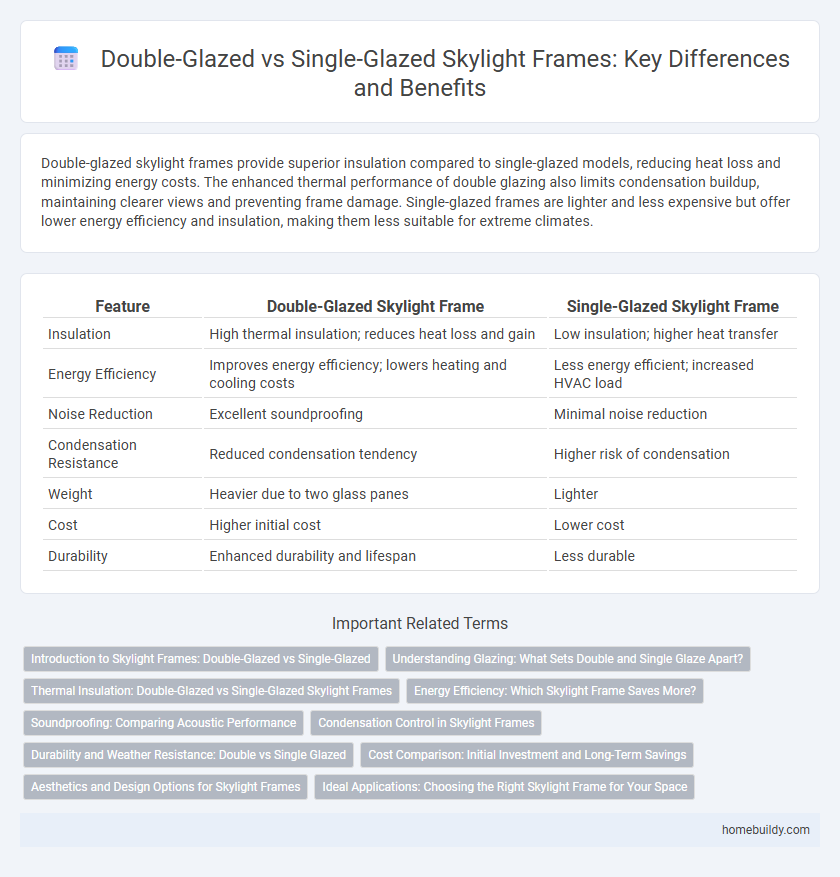Double-glazed skylight frames provide superior insulation compared to single-glazed models, reducing heat loss and minimizing energy costs. The enhanced thermal performance of double glazing also limits condensation buildup, maintaining clearer views and preventing frame damage. Single-glazed frames are lighter and less expensive but offer lower energy efficiency and insulation, making them less suitable for extreme climates.
Table of Comparison
| Feature | Double-Glazed Skylight Frame | Single-Glazed Skylight Frame |
|---|---|---|
| Insulation | High thermal insulation; reduces heat loss and gain | Low insulation; higher heat transfer |
| Energy Efficiency | Improves energy efficiency; lowers heating and cooling costs | Less energy efficient; increased HVAC load |
| Noise Reduction | Excellent soundproofing | Minimal noise reduction |
| Condensation Resistance | Reduced condensation tendency | Higher risk of condensation |
| Weight | Heavier due to two glass panes | Lighter |
| Cost | Higher initial cost | Lower cost |
| Durability | Enhanced durability and lifespan | Less durable |
Introduction to Skylight Frames: Double-Glazed vs Single-Glazed
Double-glazed skylight frames consist of two glass panes separated by a spacer, offering superior thermal insulation and energy efficiency compared to single-glazed frames, which have only one glass pane. The double glazing reduces heat transfer, minimizes condensation, and enhances soundproofing, making it ideal for climate control and comfort. Single-glazed skylight frames are generally more affordable but provide less insulation and durability, often suitable for mild climates or budget-conscious projects.
Understanding Glazing: What Sets Double and Single Glaze Apart?
Double-glazed skylight frames feature two layers of glass separated by an air or gas-filled space, providing superior thermal insulation and reducing heat transfer compared to single-glazed frames that have only one glass pane. This construction enhances energy efficiency, minimizes condensation, and improves soundproofing, making double-glazing ideal for climates with extreme temperatures. Single-glazed skylight frames offer basic natural light but lack the insulating properties and durability found in double-glazed units.
Thermal Insulation: Double-Glazed vs Single-Glazed Skylight Frames
Double-glazed skylight frames provide superior thermal insulation by incorporating two glass panes separated by an air or gas-filled gap, reducing heat transfer and enhancing energy efficiency. Single-glazed skylight frames consist of a single glass pane, offering minimal insulation and higher heat loss or gain. This improved thermal barrier in double-glazed frames helps maintain indoor temperature stability and lowers heating and cooling costs.
Energy Efficiency: Which Skylight Frame Saves More?
Double-glazed skylight frames provide superior energy efficiency compared to single-glazed frames by reducing heat transfer and enhancing insulation with two layers of glass separated by an air or gas-filled space. This design minimizes energy loss, maintaining indoor temperature stability and lowering heating and cooling costs. Single-glazed skylight frames lack this insulating barrier, resulting in higher energy consumption and less effective temperature regulation.
Soundproofing: Comparing Acoustic Performance
Double-glazed skylight frames offer superior soundproofing compared to single-glazed options by utilizing two layers of glass separated by an insulating air or gas-filled space, which significantly reduces noise transmission. The added thickness and insulation create a barrier that effectively dampens external sounds such as traffic or rainfall, enhancing indoor acoustic comfort. Single-glazed skylight frames lack this dual-layer structure, resulting in higher levels of noise infiltration and less effective sound insulation.
Condensation Control in Skylight Frames
Double-glazed skylight frames offer superior condensation control compared to single-glazed frames due to their insulated design, which significantly reduces thermal bridging and minimizes temperature differences on frame surfaces. The air or inert gas-filled space between the two glass panes acts as a barrier to moisture buildup, preventing water droplets and frost from forming. In contrast, single-glazed skylight frames are more prone to condensation as their single glass layer allows quicker heat loss, increasing the likelihood of moisture accumulation and potential damage to the frame structure.
Durability and Weather Resistance: Double vs Single Glazed
Double-glazed skylight frames exhibit superior durability and weather resistance compared to single-glazed frames due to their enhanced insulation and robust construction, which reduces condensation and thermal stress. The dual layers of glass in double-glazed frames provide better protection against harsh weather conditions, minimizing the risk of frame warping, corrosion, and leaks. Single-glazed skylight frames are more prone to damage from temperature fluctuations and moisture infiltration, leading to a shorter lifespan and increased maintenance needs.
Cost Comparison: Initial Investment and Long-Term Savings
Double-glazed skylight frames have a higher initial investment compared to single-glazed frames due to the additional glass layer and enhanced sealing technology. However, double-glazed options provide superior insulation, significantly reducing heating and cooling energy costs over time. Long-term savings from improved thermal efficiency and reduced noise infiltration often offset the upfront expense, making double-glazed skylight frames a cost-effective choice for energy-conscious homeowners.
Aesthetics and Design Options for Skylight Frames
Double-glazed skylight frames offer enhanced design flexibility with slimmer profiles and a modern aesthetic that complements contemporary architecture. Single-glazed skylight frames tend to have thicker, less refined edges that can disrupt minimalist design schemes. Opting for double glazing allows for a broader range of finishes and frame colors, increasing customization possibilities in both residential and commercial skylight installations.
Ideal Applications: Choosing the Right Skylight Frame for Your Space
Double-glazed skylight frames are ideal for residential spaces requiring enhanced insulation, noise reduction, and energy efficiency, making them perfect for climates with extreme temperatures. Single-glazed skylight frames suit areas with mild weather or structures like garden sheds and greenhouses where ventilation and natural light take precedence over insulation. Selecting the right skylight frame depends on balancing thermal performance, durability, and the specific environmental needs of the space.
Double-glazed skylight frame vs single-glazed skylight frame Infographic

 homebuildy.com
homebuildy.com